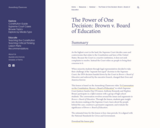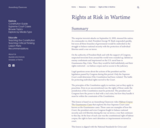
A list of radio/TV adds for the various candidates that ran in the 2016 presidential election.
- Subject:
- Social Science
- Material Type:
- Primary Source
- Provider:
- Democracy in Action
- Date Added:
- 03/22/2024

This collection contains highly recommended U.S. Government and Citizenship lessons, activities, and other resources from the eMedia library.

A list of radio/TV adds for the various candidates that ran in the 2016 presidential election.

The Path to Independence: Use this lesson after students have read the Stamp Act Resistance Narrative, The Boston Massacre Narrative, and The Boston Tea Party Narrative. This lesson should be followed by the Thomas Jefferson and the Declaration of Independence Narrative and the Thomas Paine, Common Sense, 1776 Primary Source analysis.

After losing twice in the lower courts, Plessy took his case to the U.S. Supreme Court, which upheld the previous decisions that racial segregation is constitutional under the "separate but equal" doctrine. This resource includes teacher materials, guides, and activities for teaching about this Supreme Court case.

Popular Sovereignty and the Consent of the Governed: The Founders believed that the government’s authority needed to come from the people. Under the reign of King George III, the colonists believed that they were deprived of their opportunity to consent to be governed by Parliament through representatives, and, therefore, the British could not force their laws upon the colonies. The Founders made sure to uphold this right in the American Constitution. The people, through their representatives at state ratification conventions, had to ratify the document in order for it to become law.

Case background and primary source documents concerning the Supreme Court case of Pottawatomie v. Earls. Dealing with students' Fourth Amendment protections when in schools, this lesson asks students to assess the Court's evolving definition of "reasonable" searches with respect to public school students.

This lesson is based on the Annenberg Classroom video âA Conversation on the Constitution: Brown v. Board of Educationâ in which Supreme Court Justices Sandra Day O'Connor, Anthony Kennedy and Stephen Breyer participate in a Q&A session with a group of high school students. The conversation revolves around the issues and arguments in Brown v. Board of Education. Through the lesson, students gain insight into decision-making at the Supreme Court, learn about the people behind the case, construct a persuasive argument, and evaluate the significance of Brown v. Board of Education.

Explore the shifting powers of the chief executive throughout history usig an interactive timeline and associated resources.

Khan academy video with clear visual lecture on the main features of primaries and caucuses.

A confluence of factors, including the quickening pace of industrialization, urbanization, increasing immigration, and a growing presence on the world stage faced America in the late 19th Century. These pressures gave rise to various political movements, each seeking to provide answers to the most serious questions of the day. Overall, Americans found answers to these issues in the ideas of the Progressives. From both major political parties, the Progressives offered solutions to economic, social, and political problems, in some ways using and in others changing the American system of government that had existed for a century at that point. This toolkit provides guiding questions and links to essential documents, resources, and lesson plans related to the progressive era.

This lesson has students learn about the purposes of government specified in the preamble of the Constitution. Students will use C-SPAN video clips to define what is meant by "establish Justice, insure domestic Tranquility, provide for the common defense, promote the general Welfare, and secure the Blessings of Liberty." As practice, students will apply their knowledge of these purposes by viewing real-life examples of government actions and identifying the relevant purpose of government. This lesson works well in classrooms with one-to-one devices and can be adapted to flipped classrooms.

The push towards civil rights in the United States has been longstanding and is ever-evolving. While not encompassing, our civil rights unit covers the expansion and abolition of slavery, women’s suffrage, the Civil Rights Movement of the 1950s and 60s, and the expansion of rights through court cases and laws.

In this lesson, students will gain an understanding of how the doctrine of incorporation broadened the application of the First Amendment. They will also gain an understanding of the facts of landmark Establishment Clause Supreme Court cases, evaluate arguments about the scope of the Establishment Clause, and assess the Supreme Court's interpretations of the First Amendment with respect to religion in public schools.

In this lesson, students will explore the evolution in the United States from religious toleration to religious liberty. Students will examine the difference between the two, analyze documents concerning both, and evaluate the significance of this change.

Case background and primary source documents concerning the Supreme Court case of Reno v. ACLU. Dealing with whether or not the First Amendment protected obscene or indecent speech on the internet, this lesson asks students to argue whether or not Congress should be able to ban "indecent" or "patently offensive" speech on the Internet.

In order to enjoy our tradition of rights in the United States, we must also fulfill responsibilities to assure that all can benefit from the liberty and equality on which the United States was founded. Many of the rights we can exercise have concrete responsibilities of actions we must take to assure the common good. This lesson will examine the differences between rights and responsibilities, and how both relate to the concept of the common good.

The Declaration of Independence, based in part on the philosophy of John Locke, was an “expression of the American mind”. Going back to Magna Carta, British nobles had petitioned the monarch demanding limits to his power. But Locke argues and the Declaration of Independence asserts that legitimate government is based on the consent of the governed. Locke’s ideas were too democratic, too revolutionary for his time in England, but a century later they had a firm hold in the American colonies, and in 1776 they were the basis of the original and most fundamental American statement of rights, the Declaration of Independence.

This lesson is based on an Annenberg Classroom video Habeas Corpus: The Guantanamo Cases that explores the four Supreme Court cases known as the Guantanamo cases. These cases are examples of how the Court, the president and even Congress fought to balance national security and civil liberties during the war on terror, a war that continues to this day. At the hear of each case was the constitutional right of habeas corpus, the right to have one's detention or imprisonment reviewed in court.
This lesson is aligned with the National Standards for Civics and Government and Common Core Standards. The estimated time of this lesson is two 50-minute classes.

How did we go from thirteen British colonies to the United States of America? Explore the major hardships of life under British rule, why some colonists decided to break away, and how they set a path for a new and independent government.

Case background and primary source documents concerning the Supreme Court case of Roe v. Wade. Dealing with a citizen's Constitutional right to privacy and liberty, this lesson asks students to evaluate the Court's constitutional reasoning in Roe v. Wade.

The benefits of freedom are safest when officials cannot make arbitrary and unpredictable laws. The rule of law means that laws are stable, limited in scope, and applied to every citizen, including those who make them.